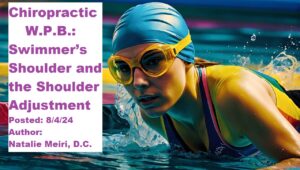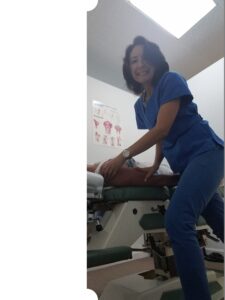
“Swimmer’s shoulder” is a term that can represent numerous shoulder conditions. These include impingement syndrome, rotator cuff tendinitis, labral injuries, ligamentous laxity or muscle imbalance causing instability, muscular dysfunction, and neuropathy from nerve entrapment. You will have weakness, pain and instability from the activity of repetitive swimming that causes any of these Swimmer’s shoulder injuries and conditions. This blog is about Chiropractic W.P.B.: Swimmer’s Shoulder and the Shoulder Adjustment.
Chiropractic W.P.B.: What is Swimmer’s Shoulder?
If you are a swimmer, you are susceptible to shoulder injury due to the repetitive nature of the training/ exercise. Even if you use different swimming strokes, this still can ultimately result in repetitive shoulder injury due to the high number of shoulder revolutions.
In many cases, the swimmer will have developed a subacromial impingement syndrome. It represents chronic irritation of the humeral head (top part of upper arm bone) and rotator cuff on the coracoacromial arch (top outer edge of shoulder blade or scapula or and consists of the acromion, coracoacromial ligament, and coracoid) during swimming.
What is shoulder impingement syndrome?
A shoulder impingement syndrome is defined as a compromise of the space between the coracoacromial arch and the proximal (situated nearer the center of the body) humerus (upper arm bone). So several structures may get impinged (pinched): The biceps tendon, superior labrum (cartilage in shoulder joint), supraspinatus (1 of the rotator cuff muscles) tendon, and the subacromial bursa (a fluid-filled sac for countering friction at a joint ) are all vulnerable to being impinged.
Causes for shoulder impingement include both structural and functional reasons:
Structural reasons:
-variant acromial types that are hooked or lengthened (top portion of shoulder blade developed/grew abnormal)
-degenerative (wear and tear arthritic) changes on the undersurface of the acromion
-an inflammatory process in the subacromial space (which could be due to i.e. bursitis, rotator cuff tear, or/and all of the above)
Functional reasons:
-abnormal position of your spine or scapula (ie. thoracic kyphosis)
-tightness of your shoulder capsule (membrane around shoulder joint),
-decrease in the space between the coracoacromial arch and proximal humerus due to past injuries
-abnormal motion due to nerve related problems (i.e. nerve palsy)

Chiropractic West Palm Beach: Mechanism of injury for Swimmer’s Shoulder/Impingement
Firstly, the swimmer’s stroke mechanics of freestyle, butterfly, and backstroke styles require the swimmer’s arms to reach over the shoulder and then enter the water. Next, the arms pull through the water in a semicircular motion, propelling the swimmer in motion. With the breast stroke, there are differences and similarities to the other styles.
Second, in the pull-through phase (underwater), the muscles involved are: pectoralis major and latissimus dorsi. In the recovery phase (hands out of water), the muscles involved are the supraspinatus, infraspinatus, middle deltoid and the serratus anterior.
Third, so depending on how the swimmer’s hand/arm is positioned when entering the water, it can create an excessive rotation causing repetitive injury.
Chiropractic West Palm Beach: Pectoral Muscles Overdeveloped compared to the Back Muscles Leading to Swimmer’s Shoulder/Impingement
The swimmer’s pectoral muscles may be overly developed compared to the other back muscles. Moreover, these back muscles are:
-scapular retractors (draws back the shoulder blades) such as the rhomboids and lower trapezius
-adductors and elevators of shoulders such as the middle rhomboids and upper trapezii, levator scapulae. And even the upper fibers of latissimus dorsi
When the above happens, the swimmer’s scapula may “wing”. Furthermore, the scapula muscles that are too weak will become fatigued. Additionally, the shoulder will be unable to rotate and move properly. Next, when the humerus is elevating, it will not clear the acromion and impingement occurs.
Lastly, the abnormal scapulothoracic (shoulder blade and mid back) motion ends in fatiguing the rotator cuff muscles (originating off the scapula). Similarly, the rotator cuff muscles which serve as dynamic shoulder stabilizers becoming fatigued effects the static stabilizers (glenoid labrum and associated capsuloligamentous components). Ultimately, this results in humeral instability/traction type stress and rotator cuff tendinitis.
Chiropractic West Palm Beach: Pectoral Muscles Overdeveloped compared to the External Rotators Leading to Swimmer’s Shoulder/ impingement
The swimmer’s pectoral muscles may be overdeveloped compared to the external rotators (infraspinatus and teres minor) of the shoulder. Because the shoulder external rotator muscles are weakened and fatigued, the greater tuberosity impinges the internal rotator muscles during abduction (raising arm at side) of the shoulder. Basically, there is dysfunctional motion/rotation of the shoulder. Therefore, the imbalance in strength between the external and internal rotator muscles of shoulder can cause a tendinitis.

Chiropractic West Palm Beach: Poor Swimming Technique and Posture Leading to Swimmer’s Shoulder/ impingement
Firstly, entering the water with the thumb first increases the amount of internal rotation in the shoulder causing abnormal motion. Entering the water with the third or fourth finger leading the arm, with your wrist slightly bent is better.
Secondly, as the swimmer “pulls” crossing the midline, this places the shoulder in a position where the rotator cuff muscles aren’t as strong.
Thirdly, the swimmer’s improper posture (forward head posture) when not swimming also effects the shoulder.
Fourthly, Amount of rotation during freestyle is a common cause of pain. If the swimmer swims flat on the water, they must extend the arm farther back past the body to recover.
Chiropractic West Palm Beach: Treatment for Swimmer’s Shoulder/ Impingement Syndrome entails:
Chiropractic adjustments/manipulation to the shoulder (e.g. glenohumeral), and associated regions. Associated regions may be the cervical (neck) and thoracic (mid back) spine. Additionally, soft tissue therapy (myofascial release, pressure point and various post isometric relaxation procedures) and modalities (cold/heat therapy and electric muscle stimulation) will be administered as needed. Finally, therapeutic exercises to continue treatment at home will be given.
The first goal is to get the swimmer out of pain. Next, restore normal range of motion to the shoulder. Finally, to strengthen the rotator cuff and scapulothoracic (mid back where the shoulder is attached) musculature. The long-range goal is to stabilize the swimmer’s shoulder with a progressive rehabilitation program. Also, recommendations for correction/modification of posture and/or occupational/daily lifestyle activities is important.
Chiropractic W.P.B.: Do you know someone with Swimmer’s Shoulder?
Meiri Chiropractic serving West Palm Beach, Jupiter, North Palm Beach, Palm Beach Gardens and the surrounding areas offers excellent chiropractic treatment for Swimmer’s shoulder/ impingement syndrome. Call 561-253-8984 today to schedule an appointment or to find out more about Chiropractic W.P.B.: Swimmer’s Shoulder and the Shoulder Adjustment.